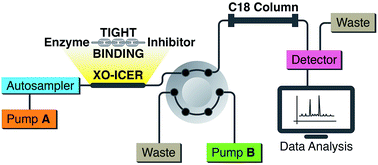Characterization and screening of tight binding inhibitors of xanthine oxidase: an on-flow assay
Abstract
Xanthine oxidase (XO) is an enzyme in the purine salvage pathway that catalyzes the oxidation of hypoxanthine to xanthine with subsequent production of uric acid from the xanthine oxidation, and it has been considered an important target of newly developed inhibitors. Based on the advantages of using immobilized capillary enzyme reactors (ICERs) in a 2D LC system as a tool for screening new enzymatic ligands, this work validated an XO-ICER using allopurinol as a positive control. Despite the complex interaction between XO and allopurinol due its tight binding nature, it was possible to recognize the inhibitory kinetics parameters through Morrison's equation. The tight binding nature of inhibition was established by varying the IC50 values according to the substrate concentration. The kinetic inhibitory profile of allopurinol was used to validate the XO-ICER. Then, the XO-ICER was used to screen specific ruthenium derivatives. The selected compound, 4CBALO, an allopurinol ruthenium derivative, exhibited 100% inhibition at 200 μM compared to 86% inhibition from allopurinol at the same concentration. The inhibitory effect on the immobilized XO was reversible after the elution of the compound, with immediate recovery of the ICER activity. Additionally, 4CBALO behaved as a selective and competitive tight binder of xanthine oxidase with a true Ki value of 0.29 μM, which was obtained from the Morrison equation. This report describes the first on-flow characterization of tight binders of xanthine oxidase.


 Please wait while we load your content...
Please wait while we load your content...